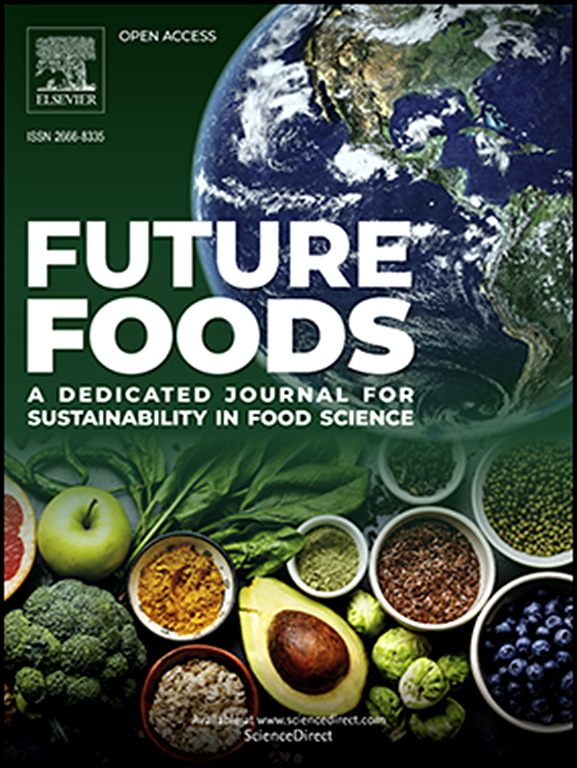同时应用折光窗和微波干燥:一种新的水果脱水混合技术,以减少干燥时间和提高生物活性化合物的保留
IF 8.2
Q1 FOOD SCIENCE & TECHNOLOGY
引用次数: 0
摘要
折射窗(RW™)和微波(MW)是两种干燥技术,具有干燥时间短、保持性高的特点。本研究使用一种新的系统:RW™辅助微波(RW- mw)来研究干燥苹果片(作为模型食品)的效果。测定干燥时间、水分含量、水活度(aw)、总多酚含量、抗氧化能力和颜色变化。利用分数阶微积分的菲克第二定律和反常扩散模型对干燥过程进行建模。干燥采用RW™和RW- mw两种功率密度:815 W/kg和1165 W/kg。RW™和RW- mw设置在98°C。在这两种情况下,都进行干燥过程,直到苹果片的水分含量低于0.097 g / g样品(湿基),aw低于0.4。通过测定总多酚含量(TPC)和抗氧化能力(AC)来评估生物活性化合物的保留。结果表明,在RW™干燥过程中,同时应用815 W/kg和1165 W/kg的微波功率密度,与单独使用RW™相比,可以减少高达66%的干燥时间,保持TPC和AC的保留。该研究表明,与RW™干燥相比,RW- mw技术可以减少干燥时间,同时保持高生物活性化合物的保留。本文章由计算机程序翻译,如有差异,请以英文原文为准。

Simultaneous application of refractance window and microwave drying: A novel hybrid technique for fruit dehydration to reducing drying time and improve bioactive compound retention
Refractance window (RW™) and microwave (MW) are two drying technologies characterized by short drying time and high-quality retention. This study investigated the effect of drying apple slices (as a model food), using a novel system: RW™ assisted with microwaves (RW-MW). Drying time, moisture content, water activity (aw), total polyphenol content, antioxidant capacity and color change were determined. The study also aimed to model the drying process through Fick’s second law and anomalous diffusion model based on fractional calculus. Drying was performed with RW™, and RW-MW using two power densities: 815 W/kg and 1165 W/kg. RW™ and RW-MW were set at 98 °C. In both cases, the drying process was performed until the apple slices reached a moisture content lower than 0.097 g of water/ g sample (wet basis) and aw below 0.4. Bioactive compound retention was assessed by measuring total polyphenol content (TPC), and antioxidant capacity (AC). The results showed that applying microwave power densities of 815 W/kg and 1165 W/kg simultaneously during RW™ drying allowed reduced drying time by up to 66 % compared to RW™ alone, maintaining the retention of TPC and AC. This study demonstrated that RW-MW is a technology that allows for reduced drying times while maintaining high bioactive compound retention compared to RW™ drying.
求助全文
通过发布文献求助,成功后即可免费获取论文全文。
去求助
来源期刊

Future Foods
Agricultural and Biological Sciences-Food Science
CiteScore
8.60
自引率
0.00%
发文量
97
审稿时长
15 weeks
期刊介绍:
Future Foods is a specialized journal that is dedicated to tackling the challenges posed by climate change and the need for sustainability in the realm of food production. The journal recognizes the imperative to transform current food manufacturing and consumption practices to meet the dietary needs of a burgeoning global population while simultaneously curbing environmental degradation.
The mission of Future Foods is to disseminate research that aligns with the goal of fostering the development of innovative technologies and alternative food sources to establish more sustainable food systems. The journal is committed to publishing high-quality, peer-reviewed articles that contribute to the advancement of sustainable food practices.
Abstracting and indexing:
Scopus
Directory of Open Access Journals (DOAJ)
Emerging Sources Citation Index (ESCI)
SCImago Journal Rank (SJR)
SNIP
 求助内容:
求助内容: 应助结果提醒方式:
应助结果提醒方式:


